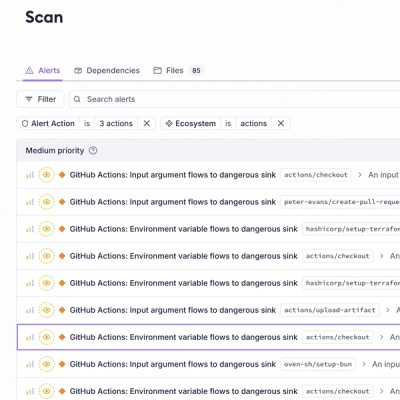
Product
Introducing Socket Firewall Enterprise: Flexible, Configurable Protection for Modern Package Ecosystems
Socket Firewall Enterprise is now available with flexible deployment, configurable policies, and expanded language support.
binder-control
Advanced tools
CLI for launching and managing binder server processes
binder-control is the main module for launching/managing all server-side Binder components. At
it's core, it's a fairly thin wrapper around the PM2
process manager that also manages optional background services (a database, a logging stack,...)
using Docker Compose.
Make sure to install these services before proceeding with the installation:
wget -qO- https://raw.githubusercontent.com/creationix/nvm/v0.31.0/install.sh | bashnvm install v5.7.1nvm use v5.7.1npm install pm2 -gIf you want to use the local Kubernetes VM for testing, also install:
binder-control is designed to be installed globally and used from the command line.
npm install binder-control -g
If you are running on a GCE instance, you'll first need to download/install the gcloud utility:
curl https://sdk.cloud.google.com | bash
gcloud components update
Then ensure that gcloud has the correct permissions to create new instances:
gcloud auth login
If you've created a new GCE instance specifically for Binder, and you'd like to proceed with the default configuration options, then binder-control start-all will
interactively launch all background services and Binder servers.
To interactively stop all services/services, call binder-control stop-all
binder-control provides built-in options for deploying the end-to-end system with either a local
version of Kubernetes (using Vagrant with VirtualBox), or with a small, preconfigured Kubernetes
cluster running on GCE.
binder-control start-service db
The db service will launch a Docker container running Mongo DB (with other launch details
specified in the binder-control configuration file).
binder-control start-service logging
The logging service launches three Docker containers running the ELK stack (Elasticsearch,
Logstash and Kibana) for collecting and indexing log messages generated by other Binder components.
If you would like to use your own logging infrastructure (i.e. use an Elasticsearch cluster for
higher logging throughput), check out binder-logging for details on how to swap out the logging
service with your existing infrastructure.
binder-control start-service kube-vm
The kube-vm service, launched with the command binder-control start-service kube-vm,
will spin up a virtual machine running Kubernetes, and will insert a kubectl binary onto your
path that can interface with this VM. This service depends on VirtualBox and Vagrant
(installation instructions here and
here respectively), which must be preinstalled
separately.
This Kubernetes VM will only be accessible on the local machine, and will not be accessible through
the binder-web interface -- it should only be used for testing binder-deploy-kubernetes during
development.
binder-control start-service kube-cluster
The kube-cluster service will prompt the user for a set of cluster configuration parameters
(cloud provider, cluster size, etc.) before creating a Kubernetes cluster. The cluster creation
process will take ~5 minutes, after which the standard Kubernetes control commands can be issued
through the kubectl.sh script, which will
be downloaded the first time kube-cluster is started.
Stopping kube-cluster will permanently destroy the cluster, so make sure any important data (such
as data stored in Kubernetes volumes) are backed up.
IMPORTANT: kube-cluster must be passed a desired cluster size, and creating a cluster with many nodes
can get very expensive. Checkout out the GCE pricing guide
to make sure your cluster size matches your budget.
If you want to use the provided logging stack, DB infrastructure, or Kubernetes test VM, the very first step is to launch these services using Docker Compose:
binder-control start-service (db|logging|kubernetes)
Once the services are all up and running, you can spin up the actual Binder servers...
with a single command, using default options:
binder-control start-all
or individually, with custom configuration files
binder-control (build|deploy-kubernetes) start --api-key=<key> --config=/path/to/config
All services and servers launched by binder-control are managed by the PM2 process manager.
To check on the status of all binder-control managed processes, see restart counts and uptime
information:
pm2 list
To see any console output or logging information:
pm2 logs <process name>
To stop background services, use the stop-service command
binder-control stop-service (db|logging|kubernetes)
To stop Binder servers, use the server name as the subcommand
binder-control (build|deploy-kubernetes) stop
FAQs
CLI for launching and managing binder server processes
We found that binder-control demonstrated a not healthy version release cadence and project activity because the last version was released a year ago. It has 1 open source maintainer collaborating on the project.
Did you know?

Socket for GitHub automatically highlights issues in each pull request and monitors the health of all your open source dependencies. Discover the contents of your packages and block harmful activity before you install or update your dependencies.

Product
Socket Firewall Enterprise is now available with flexible deployment, configurable policies, and expanded language support.

Security News
Open source dashboard CNAPulse tracks CVE Numbering Authorities’ publishing activity, highlighting trends and transparency across the CVE ecosystem.

Product
Detect malware, unsafe data flows, and license issues in GitHub Actions with Socket’s new workflow scanning support.